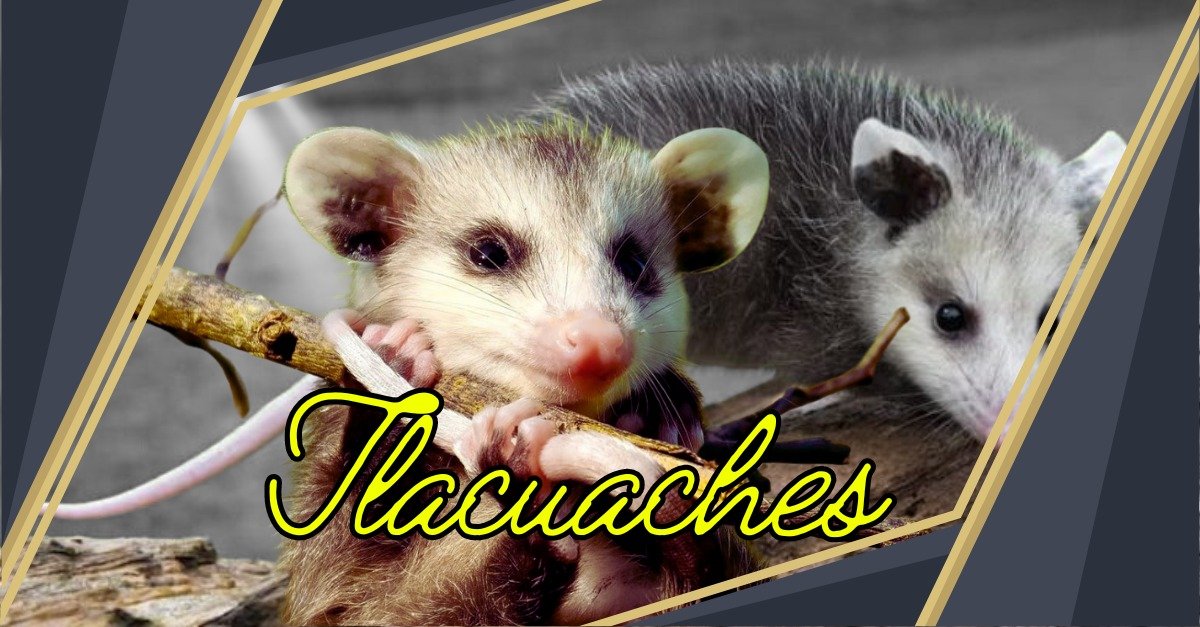The tlacuache, also known as a common opossum, is a fascinating and unique animal that holds a special place in many cultures, particularly in Mexico and Central America. Often misunderstood due to its unusual appearance, the tlacuache is actually a resilient creature with an interesting background. In this blog post, we will explore what a tlacuache is, its characteristics, cultural significance, and answer common questions people have about it.
What is a Tlacuache?
The word “tlacuache” comes from the Nahuatl language, used by the Aztecs, and it refers to the opossum. Tlacuaches are marsupials, animals that carry and nurse their young in pouches, much like kangaroos. They belong to the Didelphidae family, and while they are often compared to their cousins in North America, they have some key differences that make them stand out.
In Mexican and Central American cultures, tlacuaches have a long-standing history and are considered both a symbol of survival and adaptability. With their keen sense of smell and climbing abilities, they can thrive in various environments, from dense forests to urban areas.
Tlacuache in English: What’s the Translation?
The term “tlacuache” translates directly to “opossum” in English. However, the opossum found in the United States is slightly different from the tlacuaches found in Central and South America. While they share the same family, the American opossum tends to have a more widespread habitat, including colder regions, whereas the tlacuache prefers warmer climates.
The two are similar in appearance, with grayish fur, pointed snouts, and hairless tails. Despite their seemingly unattractive look, they play an important role in the ecosystem. Tlacuaches help control insect and rodent populations, making them beneficial to humans in many ways.
Why Do Tlacuaches Have Hairless Tails?
One of the most distinct features of the tlacuache is its hairless tail. This adaptation is not just cosmetic; it serves a very practical purpose. Their prehensile tail acts like a fifth limb, helping them grasp branches and stabilize themselves while climbing trees. It also allows them to carry objects and balance, which is essential in their natural habitats. The hairless tail makes it easier for the tlacuache to use its tail for grip and mobility, giving it an evolutionary advantage in the wild.
In addition, their tails help regulate body temperature. Since hairless skin loses heat more easily than fur-covered areas, their tails are a useful tool for staying cool in warmer climates. This feature is part of what makes the tlacuache so adaptable to different environments.
Can You Eat Tlacuache?
While it may sound unusual to some, there are regions where eating tlacuache is a cultural practice. In certain areas of Mexico and Central America, the tlacuache has been consumed for centuries. The practice is more common in rural communities where the animal is more plentiful and considered a source of protein. However, it’s not a widespread practice, and in many areas, eating tlacuache is more of a historical tradition than a modern one.
The preparation of tlacuache as food involves traditional cooking methods such as roasting or stewing. Some believe that the meat has medicinal properties and can help with ailments like arthritis. It’s important to note that while it is possible to eat tlacuache, it is not a common dish, and most people in modern times do not include it in their diet.
Tlacuache as Slang: What Does it Mean?
In Mexico and other parts of Latin America, “tlacuache” has taken on a slang meaning beyond its literal definition. In some contexts, calling someone a tlacuache is not a compliment. It is often used to describe someone who is sneaky or crafty, similar to how people might refer to someone as a “fox” in English.
However, the slang usage of the term can also refer to someone who is seen as dirty or unkempt, reflecting the animal’s somewhat scruffy appearance. Like many slang terms, its meaning can vary depending on the region and context, but it usually carries a negative connotation. Despite this, the animal itself remains a vital part of local wildlife.
Habitat and Behavior of Tlacuaches
Tlacuaches are highly adaptable animals, capable of thriving in a wide range of environments. They are primarily nocturnal, meaning they are most active at night. During the day, they hide in burrows, tree hollows, or even in man-made structures such as attics and sheds.
In the wild, tlacuaches are opportunistic feeders. They have an omnivorous diet, consuming a variety of foods, including fruits, insects, small mammals, and even carrion. This diverse diet is one of the reasons they have been able to survive in both natural and urban settings.
Their ability to play dead, known as “playing possum,” is a defense mechanism. When threatened, a tlacuache may fall over, remain completely still, and excrete a foul-smelling fluid to deter predators. This act is so convincing that many animals leave them alone, thinking they are already dead.
Interesting Facts About Tlacuaches You Didn’t Know
Did you know that tlacuaches are immune to snake venom? This is one of their most fascinating traits, and it allows them to prey on snakes without fear of being harmed. Their resistance to venom is a remarkable evolutionary trait that has helped them survive in environments where dangerous snakes are present.
Another interesting fact is that female tlacuaches can give birth to up to 20 babies at a time. However, not all of these babies survive, as only a few can fit into the mother’s pouch to nurse. The survival of the fittest starts early for these young marsupials.
Tlacuache vs. Opossum: Are They the Same?
While the terms “tlacuache” and “opossum” are often used interchangeably, they refer to slightly different animals. Both belong to the same family, but the tlacuache typically refers to species found in Mexico and Central America, whereas the term “opossum” is more commonly used to describe the species found in North America.
Despite their differences in geography, both animals share many similarities, including their nocturnal habits, omnivorous diet, and ability to play dead when threatened. The main distinction lies in their habitats and some minor physical traits.
Are Tlacuaches Dangerous?
Tlacuaches are generally not dangerous to humans, and their behavior reflects their inherently timid nature. These shy marsupials tend to avoid confrontation, preferring to retreat from potential threats. When faced with danger, a tlacuache’s instinct is to escape or resort to an impressive survival tactic: playing dead. This act of “playing possum” can be quite effective, as many predators are dissuaded from pursuing an animal they believe to be lifeless.
Although tlacuaches possess sharp teeth, they rarely use them defensively unless they feel cornered or directly threatened. Even in urban environments, where encounters with humans may occur more frequently, tlacuaches typically exhibit non-aggressive behavior. They may rummage through garbage cans or sneak away with pet food, but these actions are more about survival than aggression.
In fact, tlacuaches can be beneficial to humans and the environment. By preying on insects and small rodents, they help control pest populations, contributing positively to the ecosystem. Their presence in gardens and neighborhoods can reduce the number of harmful pests, making them more allies than threats. Thus, understanding their behavior helps to appreciate these fascinating creatures rather than fearing them.
Conclusion: What Makes Tlacuaches Fascinating?
Tlacuaches are more than just another wild animal; they embody the spirit of survival and adaptability. These remarkable creatures thrive in various environments, from dense forests to bustling urban areas, showcasing their resilience and versatility. Their ability to navigate both rural and urban settings makes them a unique and vital part of the animal kingdom.
Often seen as symbols of cunning and resourcefulness in local folklore and slang, tlacuaches capture the imagination of those who encounter them. They are often misunderstood, yet they play a crucial role in maintaining ecological balance by controlling pest populations, such as insects and small rodents. Their omnivorous diet allows them to fit seamlessly into different ecosystems, acting as scavengers that contribute to the natural cycle of life.
Moreover, their intriguing behaviors, such as playing dead and their distinct hairless tails, only add to their allure. As more people become aware of their significance, tlacuaches are starting to be appreciated for their ecological contributions and unique characteristics. By taking the time to learn about these fascinating marsupials, we can foster a greater appreciation for wildlife and the importance of preserving their habitats for future generations.
FAQs
1. Can you keep a tlacuache as a pet?
While it is not common, some people do keep tlacuaches as pets. However, it is not recommended as they are wild animals and may not adapt well to captivity.
2. Do tlacuaches carry diseases?
Like many wild animals, tlacuaches can carry diseases such as leptospirosis, but they are not typically a major threat to human health.
3. How long do tlacuaches live?
In the wild, tlacuaches typically live for around 2 to 4 years. Their lifespan may be longer in captivity.
4. Are tlacuaches endangered?
No, tlacuaches are not considered endangered. They are widespread and adaptable, which has helped them avoid significant population declines.
5. How do tlacuaches communicate?
Tlacuaches use a variety of vocalizations, including hissing and growling, to communicate with each other, especially when threatened.
For more information about wildlife and related topics, visit Try Hard Guides for more engaging content.










